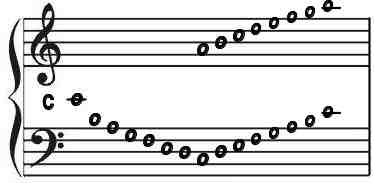
| MAJOR KEYS AND RELATIVE MINOR KEYSI thought I had enough to think about in the sections I've covered up till now. This section however, complicates things more. If you are lucky enough to be able to recognize tones and just can't figure out what is going on with a certain scale, that sounds like it has many accidentals or random accidentals, it might be a minor scale. There are actually five modes to minor scales. These are as follows: |
| Natural | Pure scale |
| Harmonic | 7th tone raised 1/2 step ascending and descending |
| Melodic | 6th and 7th tone raised 1/2 step ascending and normal descending |
| Gypsy | 4th and 7th raised 1/2 step |
| Tonic | 3rd and 6th tones of major scale is lowered 1/2 step |
| Mel Bay's Deluxe Guitar Scale Book. Mel Bay Publications, Inc. 1973. | |

| B major |  |
| G# Minor |
| In the example above the keys of B major and its relative G# minor both have the same signatures, even though the notes are different. In the Key of B major, F-C-G-D-A are sharp. In the example above on the F clef the sharp notes are A-E-B-F-C. However we are not concerned with the names of those notes. I am only showing how the major and relative minor keys assume the same key signatures. For our purposes, we change the F clef to a G clef and rename the scale G# minor. We don't even have a key called G# major. If we had it would require a F## to keep in step with the step program. The minor is possible because the steps are different. There are 13 relative minor keys in relation to major keys. I've arranged them in a table which you will find HERE |